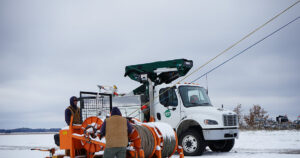Electric cooperatives are no strangers to challenge. In fact, co-ops are quite adept at embracing change and making the most of it, as evidenced, for example, by co-ops’ leadership in advancing new technologies to meet the changing needs of consumers and the electricity grid. The next big challenge is upon us. It takes the form of new federal requirements that will change the way many co-ops produce electricity, raise electricity prices, and force the shutdown of coal-fired power plants with plenty of useful life left in them.
I’m talking about the U.S. Environmental Protection Agency’s Clean Power Plan, which is an extremely complex scheme that requires a 32 percent reduction in carbon dioxide emissions from U.S. electricity by 2030. The U.S. Environmental Protection Agency (EPA) finalized the rule in August, and it will become law by the end of the year. To meet this challenge, the National Rural Electric Cooperative Association (NRECA) and electric cooperatives are working on a two-part strategy: preparing to comply with the new rule, while at the same time challenging it in the courts.
Too little, too late
We appreciate EPA’s efforts to address some of our concerns with its proposed rule. In the end, however, these efforts amounted to too little, too late. Our message to EPA-and the courts-remains the same. The plan is an ill-conceived rule that will hit electric co-ops particularly hard. EPA acknowledges that the regulations will cause some co-op power plants to shut down. The forced closure of coal-based power plants still repaying loans used to build or upgrade those plants means co-op member-owners will be paying twice for their electricity: once for the shuttered plant and again to buy power from somewhere else.
At the time these power plants were built, federal policy encouraged the use of coal to generate electricity. Now co-ops are being penalized for following the rules years ago.
In addition, those responsible for ensuring the reliability of our nation’s electric power system have raised red flags about the plan’s impact. They believe the EPA underestimated the amount of time it would take to build new power plants needed to comply with the rule. The North American Electric Reliability Corporation has said that “constructing the resource additions, as well as the expected transmission enhancements, may represent a significant reliability challenge given the constrained time period for implementation.”
EPA: making energy policy
Another one of the most notable aspects of the EPA’s plan is how far-reaching it is. The plan doesn’t just make environmental policy-it makes energy policy. That’s not EPA’s responsibility, and it has far overstepped the boundaries of its authority.
Typically, EPA has regulated and required changes at individual power plants in order to achieve new environmental goals. Co-ops have successfully been dealing with this for years. But the Clean Power Plan’s requirements can’t be met solely by implementing changes at the coal-based power plants. Instead, co-ops and other power producers will have to build new natural gas generation and renewable energy resources, and invest in end-use energy efficiency measures, to achieve the emissions cuts sought by EPA. Co-ops embrace these technologies, but the decisions on using these resources should be made by local co-op boards, not EPA officials.
On October 23, NRECA petitioned the D.C. Circuit Court of Appeals to review the Clean Power Plan and recognize that the EPA has over-stepped its legal authority. Thirty-nine G&T co-ops, 26 states and countless other groups have done the same. And Congress is weighing in with resolutions of disapproval. The EPA plan goes far beyond what the law allows it to do and will seriously challenge our nation’s electric system.

NRECA, with help from the co-op community, has asked the courts to stay the rule, which would effectively halt EPA in its tracks while the court determines whether the rule is legal under the Clean Air Act. We asked for this “time-out” because the rule will force co-ops to make near-term, expensive decisions to invest billions to meet other environmental requirements and begin to prepare to comply with this rule. Recently, there was an EPA rule that was ultimately rejected by the Supreme Court after years of litigation. But the damage had already been done because co-ops and others had made decisions to close power plants and invest billions to comply with the rule. Let’s determine the rule’s legality before making irrevocable and expansive decisions.








